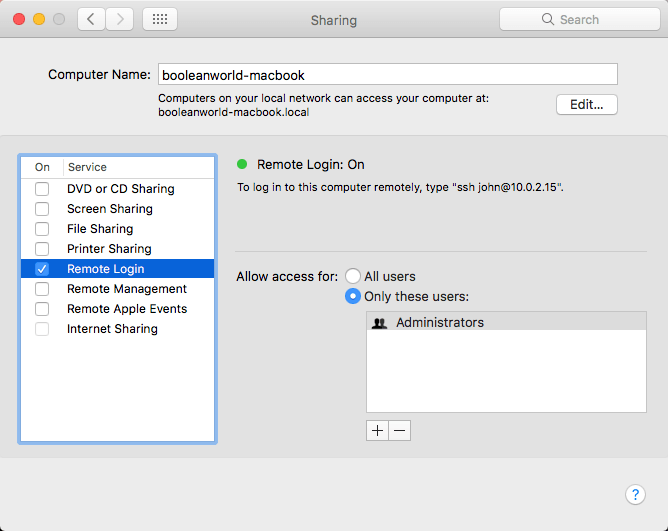Unix Commands For Mac Os X
Mar 21, 2018 Every command is made up of three elements: the command itself, an argument which tells the command what resource it should operate on, and an option that modifies the output. So, for example, to move a file from one folder to another on your Mac, you’d use the move command 'mv' and then type the location of the file you want to move. Nov 29, 2018 Mac OS. This is the operating system that runs on Macintosh computers. Mac OS is UNIX based with a Darwin Kernel and so the terminal lets you basically enter the commands directly into that UNIX environment. If you have used Linux box before you might actually have experienced the exact same sort of commands on them as on Mac OS.
To use any of these key combinations, press and hold the keys immediately after pressing the power button to turn on your Mac, or after your Mac begins to restart. Keep holding until the described behavior occurs.
- Command (⌘)-R: Start up from the built-in macOS Recovery system. Or use Option-Command-R or Shift-Option-Command-R to start up from macOS Recovery over the Internet. macOS Recovery installs different versions of macOS, depending on the key combination you use while starting up. If your Mac is using a firmware password, you're prompted to enter the password.
- Option (⌥) or Alt: Start up to Startup Manager, which allows you to choose other available startup disks or volumes. If your Mac is using a firmware password, you're prompted to enter the password.
- Option-Command-P-R:Reset NVRAM or PRAM. If your Mac is using a firmware password, it ignores this key combination or starts up from macOS Recovery.
- Shift (⇧): Start up in safe mode. Disabled when using a firmware password.
- D: Start up to the Apple Diagnostics utility. Or use Option-Dto start up to this utility over the Internet. Disabled when using a firmware password.
- N: Start up from a NetBoot server, if your Mac supports network startup volumes. To use the default boot image on the server, hold down Option-N instead. Disabled when using a firmware password.
- Command-S: Start up in single-user mode. Disabled in macOS Mojave or later, or when using a firmware password.
- T: Start up in target disk mode. Disabled when using a firmware password.
- Command-V: Start up in verbose mode. Disabled when using a firmware password.
- Eject (⏏) or F12 or mouse button or trackpad button: Eject removable media, such as an optical disc. Disabled when using a firmware password.
If a key combination doesn't work
If a key combination doesn't work at startup, one of these these solutions might help:


- Be sure to press and hold all keys in the combination together, not one at a time.
- Shut down your Mac. Then press the power button to turn on your Mac. Then press and hold the keys as your Mac starts up.
- Wait a few seconds before pressing the keys, to give your Mac more time to recognize the keyboard as it starts up. Some keyboards have a light that flashes briefly at startup, indicating that the keyboard is recognized and ready for use.
- If you're using a wireless keyboard, plug it into your Mac, if possible. Or use your built-in keyboard or a wired keyboard. If you're using a keyboard made for a PC, such as a keyboard with a Windows logo, try a keyboard made for Mac.
- If you're using Boot Camp to start up from Microsoft Windows, set Startup Disk preferences to start up from macOS instead. Then shut down or restart and try again.
Remember that some key combinations are disabled when your Mac is using a firmware password.
Learn more
- Learn what to do if your Mac doesn't turn on.
- Learn about Mac keyboard shortcuts that you can use after your Mac has started up.

A command prompt is a non-graphical interface that allows you tointeract with your operating system. At the command prompt, you entercommands by typing their names followed by options and arguments. Mostmodern computers use a graphical user interface (GUI),which allows users to more intuitively access programs anddocuments. However, some programs and commands are still onlyavailable only through a command prompt. To access the command prompt,follow the instructions appropriate to your operating system.
Windows

To access the command prompt in Windows, in Windows 7, click theStart button and enter cmd. In other versions,from the Start menu, select Run... and thenenter cmd.
For information about commands you can use in the Windows commandprompt, see ARCHIVED: What are some examples of common DOS commands?
List Of Unix Commands Pdf
Mac OS X
Mac OS X is built on a version of Unix calledDarwin. To access the Unix command prompt in Mac OS X, openthe Terminal application. It is located by default insidethe Utilities folder, which in turn is inside theApplications folder.
For information about Unix commands, see Introduction to Unix commands.
Unix
Mac Commands For Terminal
When you log into a Unix computer, your shell begins to runand provides you with a command prompt. The command prompt'sappearance varies depending on the shell you're using. For informationto help you select a shell, see About Unix shell differences
Terminal Commands For Mac
For information about Unix commands, see Introduction to Unix commands.
